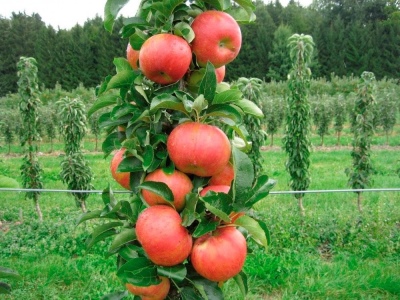
- Taste: sweet, velvety, with a pleasant sourness
- Scent: present
- Fruit weight, g: 120-160, maximum - 250
- Fruit size: large
- Yield: up to 5-6 kg per tree
- The beginning of fruiting varieties: for 2-3 years
- Ripening terms: late autumn
- Removable maturity: in September
- Keeping quality: until January
- Early maturity: early
When choosing a type of apple tree for planting on a personal plot, the gardener, first of all, chooses varieties that give a good harvest, do not take up much space and bear fruit early. This is what the winter apple tree with the beautiful name Idol belongs to, which more and more often can be found in the garden from people.
Breeding history of the variety
The history of the breeding of this apple-tree column is not fully known. Everyone knows that the variety has a long history, since such types of fruit crops were actively worked on in the 70s, and it turned out in the course of work on creating a compact variety with abundant yield indicators.
Today, apple-trees are very popular, as they are completely non-capricious, they delight with abundant harvests, and they can also be planted close to each other.
Description of the variety
Apple tree Kumir is a low-growing columnar tree with a very compact crown with moderate leaf density. The girth of the apple tree crown does not exceed 40-50 cm. Outwardly, the tree resembles a medium-sized bush, hung with beautiful fruits. The root system of the tree is fibrous, requiring regular moisture.
Features, pros and cons
The columnar fruit crop of the late autumn ripening period, like other apple trees, is characterized by many features, thanks to which many gardeners liked it.
The pluses of culture include:
early onset of fruiting,
high taste qualities of fruits,
immunity to diseases and fungal infections,
good winter hardiness,
compactness,
unpretentious care
sufficient keeping quality of fruits (the harvested crop can be stored until January).
There were no minuses in the apple variety, however, the disadvantages include the high cost of tree seedlings, as well as the fragility of the root system and branches.
Ripening and fruiting
The flowering of the apple-tree column is not as attractive as in ornamental or ornamental-fruit crops, since small flowers rarely appear. The flowering period lasts up to 10 days.
The first apples appear on the tree at the end of September, and reach full maturity in October. The tree bears fruit for 2-3 years of growth, but its fruiting is stable and annual. Fruits ripen at the same time, so they do not crumble.
The first flowers that may appear in the first year of the tree's growth are recommended to be picked in order to get bountiful harvests in the future.
Growing regions
This variety easily adapts to different climatic conditions, so it can grow and give bountiful harvests in almost any region. The most favorable will be the area with a warm climate.
Yield
On average, for 4-5 years of tree growth, up to 5-6 kg of fruits can be harvested. Fruiting continues for 15 years.
Fruits and their taste
Apples are characterized by a rounded-conical shape with pronounced ribbing. Average weight of fruits - 120-160 grams, and with abundant fruiting, when the tree grows for 7-10 years, you can pick apples weighing up to 250 g. The fruit tastes very tasty - sweet and sour, aromatic, with soft and juicy pulp. The zest of apples Idol is considered to be their unusual color - red-striped with a raspberry blush.The peel of the fruit is soft, of medium thickness, perfectly smooth with a waxy coating.

Growing features
For planting seedlings, an area is required that is well lit by the sun and reliably protected from drafts and gusts of wind. The soil should be cleaned of weeds, moistened, and saturated with fertilizers. Fertile, breathable, loamy or sandy loam soil will be optimal for seedlings. Planting seedlings is allowed both in spring and autumn.



Pollination
Apple culture Kumir is a self-pollinated variety, therefore it does not need donor trees.
Top dressing
Fertilization of the crop is carried out after the appearance of the leaves and is carried out twice with an interval of several weeks. During this period, mullein, saltpeter or urea are introduced. In autumn, at the end of the harvest, it is recommended to add superphosphates.

Frost resistance
Winter resistance of the variety is high, however, protection of the root system and trunk is sometimes required. To do this, the trunk is wrapped in burlap and the near-stem zone is mulched with peat and sawdust.

Diseases and pests
The variety has high immunity to scab and powdery mildew, but prevention is recommended. For spraying that protects against the invasion of pests and fungal diseases, special preparations must be used.

The apple tree is a popular fruit crop among gardeners. It can be found in many summer cottages. But at the same time, such trees are often affected by various diseases. It is very important to recognize the disease in time and carry out the necessary procedures for a speedy recovery.Otherwise, the fruits will be spoiled, and the tree itself may die altogether.

Review overview
Analyzing the many reviews of gardeners and farmers that they grow the crop for commercial purposes, it can be argued that the Kumir apple tree is not capricious in care, quickly gets used to the soil and climate of the region, and also gives a tasty and rich harvest. Farmers focus on high quality of fruits, good transportability and keeping quality of fruits.











































































